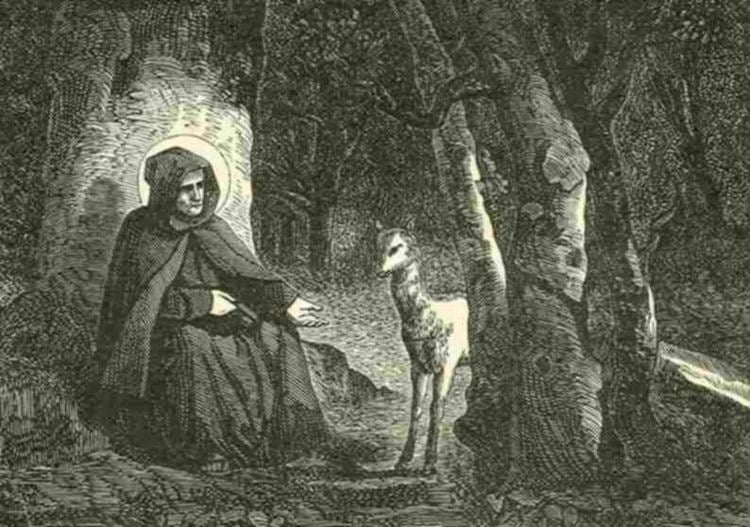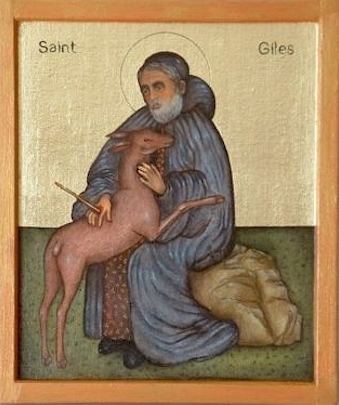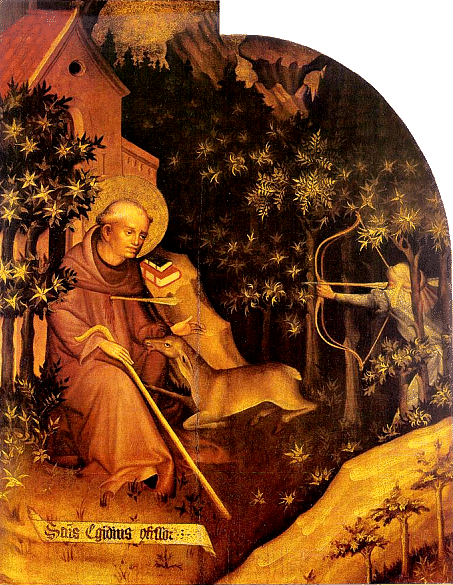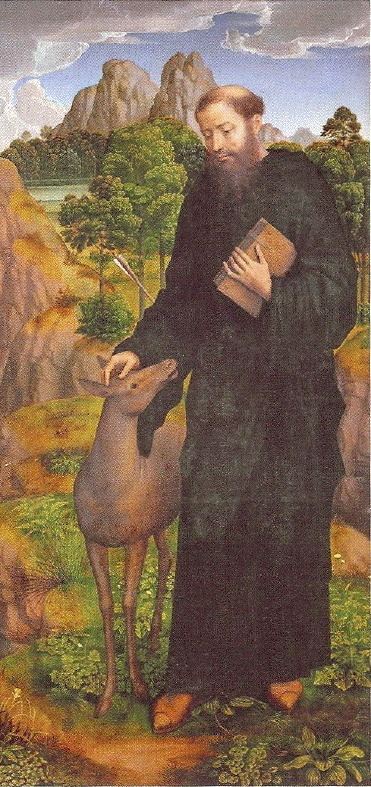Canonized Pre-Congregation Feast September 1 | Name Saint Giles | |
 | ||
Venerated in Roman Catholic ChurchEastern Orthodox ChurchAnglican Communion Similar People Master of Saint Giles, Pierre de Castelnau, George Gilbert Scott, Pope Hyginus | ||
Saint giles cathedral edinburgh scotland
Saint Giles (, Latin: Aegidius; French: Gilles; c. 650 AD – c. 710), also known as Giles the Hermit, was a Greek, Christian, hermit saint from Athens, whose legend is centered in Provence and Septimania. Giles founded the abbey in Saint-Gilles-du-Gard whose tomb became a place of pilgrimage. It was a stop on the road that led from Arles to Santiago de Compostela, the pilgrim Way of St. James. Giles is one of the Fourteen Holy Helpers.
Contents

Saint Giles
Life

Giles first lived in retreats near the mouth of the Rhône and by the River Gard in Septimania, today's southern France. The story that he was the son of King Theodore and Queen Pelagia of Athens is probably an embellishment of his early hagiographers; it was given wide currency in the Legenda Aurea. The two main incidents in his life were often depicted in art.

The Legenda Aurea links him with Arles, but finally he withdrew deep into the forest near Nîmes, where in the greatest solitude he spent many years, his sole companion being a deer, or red deer, who in some stories sustained him on her milk. Giles ate a vegetarian diet. This retreat was finally discovered by the king's hunters, who had pursued the hind to its place of refuge. An arrow shot at the deer wounded the saint instead, who afterwards became a patron of cripples. The king, who by legend was Wamba, an anachronistic Visigoth, but who must have been (at least in the original story) a Frank due to the historical setting. He held the hermit in high esteem for his humility rejected all honors save some disciples. Wamba built him a monastery in his valley, Saint-Gilles-du-Gard, which Giles placed under the Benedictine rule. He died there in the early part of the 8th century, with the highest repute for sanctity and miracles.

A 10th-century Vita sancti Aegidii recounts that, as Giles was celebrating Mass to pardon the Emperor Charlemagne's sins, an angel deposited upon the altar a letter outlining a sin so terrible Charlemagne had never dared confess it. Several Latin and French texts, including the Legenda Aurea refer to this hidden "sin of Charlemagne". This legend, however, would be contradicted by generally accepted later dates for the life of Charlemagne (approximately 742 – 28 January 814).

A later text, the Liber miraculorum sancti Aegidii ("The Book of Miracles of Saint Giles") served to reinforce the flow of pilgrims to the abbey.
Veneration
Around the abbey allegedly founded by him in the 7th century, the town of St-Gilles-du-Gard sprang up. The abbey (which was re-dedicated to him in the 10th century) remained the center of his cult, which was particularly strong in Languedoc, even after a rival body of Saint Giles appeared at Toulouse. His cult spread rapidly far and wide throughout Europe in the Middle Ages, as is witnessed by the countless churches and monasteries dedicated to him in France, Spain, Germany, Poland, Hungary, Slovakia, and Great Britain; by the numerous manuscripts in prose and verse commemorating his virtues and miracles; and especially by the vast concourse of pilgrims who from all Europe flocked to his shrine.
In 1562, the relics of the saint were secretly transferred to Toulouse to save them from the Huguenots and the level of pilgrimages declined. With the restoration of a great part of the relics to the abbey of Saint-Gilles-du-Gard in 1862, and the publicized rediscovery of his former tomb there in 1865, the pilgrimages recommenced.
Saint Giles is the patron saint of cripples and is also invoked as a saint for childhood fears, convulsions, depression, particularly in Normandy, for example in Eure Iville, Saint-Germain-Village or Bernay or in Calvados, Gilles Touques. In medieval art, he is depicted with his symbol, the hind. His emblem is also an arrow. Giles is one of the Fourteen Holy Helpers, and the only non-martyr, initially invoked as protection against the Black Death. His feast day is 1 September.
Besides Saint-Gilles-du-Gard, nineteen other cities bear his name. Cities that possess relics of St. Giles include Saint-Gilles, Toulouse and a multitude of other French cities; Antwerp, Brugge and Tournai in Belgium; Cologne and Bamberg in Germany; Rome and Bologna in Italy; Prague in the Czech Republic; and Esztergom in Hungary. Giles is also the patron saint of Edinburgh, the capital of Scotland, where St. Giles' Cathedral is a prominent landmark. He is also the patron saint of: Graz, Nuremberg, Osnabrück, Sankt Gilgen, Brunswick, Wollaberg, Saint-Gilles (Brussels Capital Region) and Saint-Gillis-Waas. In 1630, the church of Sant'Egidio in Trastevere in Rome was dedicated to him, and which since 1968 has housed the lay Community of Sant'Egidio.
The centuries-long presence of Crusaders, many of them of French origin, left the name of Saint Giles in some locations in the Middle East. Raymond of St Gilles lent his name to St. Gilles Castle (Arabic: Qala’at Sanjil) in Tripoli, Lebanon.
